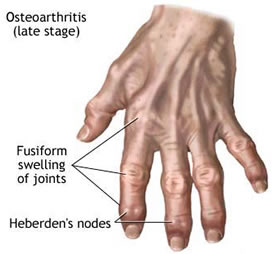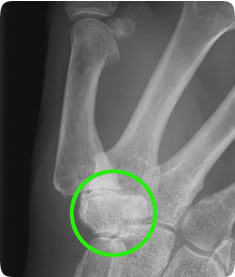Arthritis in the hand and fingers
 Osteoarthritis frequently affects the
joints of the hand and fingers. The symptoms of arthritis are pain, reduced movement, swelling and in more
advanced cases deformity.
Osteoarthritis frequently affects the
joints of the hand and fingers. The symptoms of arthritis are pain, reduced movement, swelling and in more
advanced cases deformity.
Healthy joint surfaces are covered with a very smooth layer of cartilage; in osteoarthritis the cartilage layer becomes worn and the rough bone beneath it is exposed. The rough surface does not move freely and causes pain, stiffness and swelling. Osteoarthritis may be caused by wear and tear over a long period, or occur after an injury, particularly a fracture around a joint.
Arthritis in the hand and fingers in the early stages is usually treated symptomatically with anti-inflammatory painkillers. I will recommend the best treatment with modern non-steroidal anti-inflammatory medicines (NSAIDS) and dietary supplements that may also help. Hand therapy treatments are often helpful, these include splintage to help an acute painful episode settle down, and joint strengthening programmes. Joint stabilisation programmes are particularly useful for the wrist and base of thumb joint.
In cases where pain cannot be controlled with simple symptomatic measures, a steroid injection may be considered. Steroid injections are in most cases done in the clinic. I have great experience with steroid injections into the small joints of the hand; I use local anaesthetic and perform the injections gently. Steroid injections do not have immediate effect – the onset of the effect takes about 10 days. A steroid injection typically lasts 3-6 months. Steroid injection into a painful arthritic joint can be repeated once the effect wears off.
 Surgery is indicated when other treatments have not been effective or are not likely to work, usually in advanced cases. Surgical treatments fall into two groups, joint replacement and joint fusion. Joint replacement surgery is sometimes used for the knuckle joints (MCP joints) and the first joint of the finger (PIP joint). There are various types of joint replacements; some are made of a flexible material called silicone, and some are made of a hard material called pyrocarbon. Joint fusion is a simpler operation where a severely damaged joint is removed and the bones either side fixed together. Joint fusion is a simpler operation than joint replacement. Fusion is effective to relieve pain but has the disadvantage that movement at the joint is lost. Loss of movement is less problematic in the end joints of the fingers and thumb (DIP joints) than the MCP and PIP joints. Arthritis of the small joints in the hand itself may also be treated by fusion.
Surgery is indicated when other treatments have not been effective or are not likely to work, usually in advanced cases. Surgical treatments fall into two groups, joint replacement and joint fusion. Joint replacement surgery is sometimes used for the knuckle joints (MCP joints) and the first joint of the finger (PIP joint). There are various types of joint replacements; some are made of a flexible material called silicone, and some are made of a hard material called pyrocarbon. Joint fusion is a simpler operation where a severely damaged joint is removed and the bones either side fixed together. Joint fusion is a simpler operation than joint replacement. Fusion is effective to relieve pain but has the disadvantage that movement at the joint is lost. Loss of movement is less problematic in the end joints of the fingers and thumb (DIP joints) than the MCP and PIP joints. Arthritis of the small joints in the hand itself may also be treated by fusion.
Following the surgical treatments described, hand therapy is important; my hand therapy team will provide custom-made light weight splints to protect the hand and supervise a hand therapy programme.


